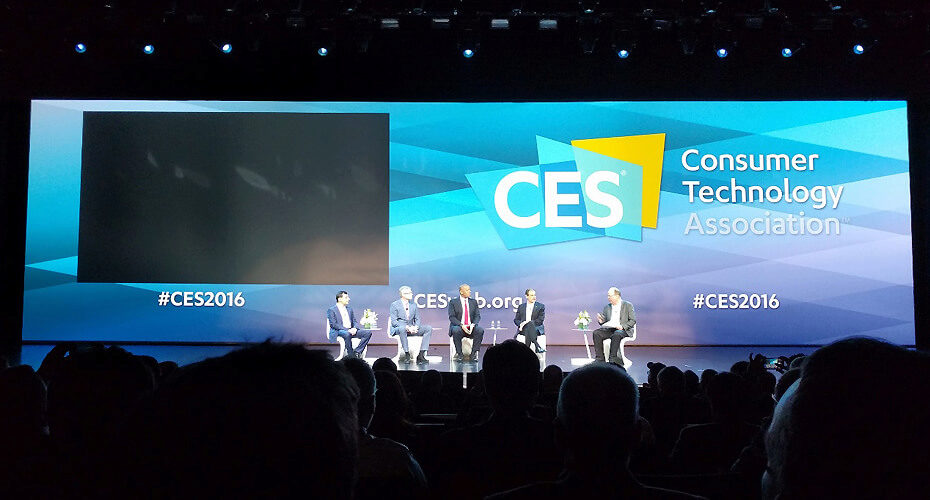A guest post by MBA student Michael Parent

Not long ago I took a trip to a convention in Las Vegas. If I were to show you the pictures and videos from the event, you would assume I went to a big auto show. Covering over 200,000 square feet of space inside and outside the Las Vegas Convention Center, nearly every major automaker (and one new one) showed off their latest models and concepts. This was not, however, an international auto show. It was the 2016 Consumer Electronics Show.
As a car enthusiast with a love for technology, I’ve been fascinated with the direction the automotive industry is heading. I got first-hand exposure to these changes during my summer at Tesla Motors, and attending CES gave me the opportunity to see how other companies are envisioning the future. Based on the number of inquiries I’ve gotten about my internship and the multitude of class projects we’ve all seen focusing on Tesla or Uber, I wanted to share my experience at CES to provide a flavor of what’s happening.
Two major automotive themes at CES were urban mobility and connected cars. “Connected car” took on one of two meanings: how future cars will integrate with technology in our lives or how they will connect to a network of vehicles and the surrounding environment. The latter was more interesting and ties in well with the burgeoning interest in “urban mobility,” which focuses on what transportation will look like in cities of the future.
With a plethora of ride-sharing options popping up and the huge growth of Uber and Lyft, it’s clear we are changing the way we get around. The rise of autonomous vehicles presents an interesting variable in that equation. One of the conference’s panels was titled “The Future of Urban Mobility” and included the U.S. Secretary of Transportation Anthony Foxx and CEOs from Mobileye, Bosch, and Qualcomm. Bringing together industry, government, and academia provided interesting perspectives on the rapidly changing landscape in urban mobility.

To reach full autonomy, cars must be able to operate in cities, which is a much more complicated problem than the highway-driving capabilities available today. The sheer number of variables in urban areas necessitates very sophisticated technology both inside the car and out. The tech members of the panel discussed a network of Dedicated Short-Range Communication (DSRC) sensors installed in the cars as well as objects around the city, such as light posts, buildings, and signs. This would allow the cars to communicate not only with each other, but also with the inanimate objects that can relay information and give the cars a very detailed picture of current road conditions. These sensors would work in unison with the other sensors and cameras in the car to allow it to navigate around the city.
A network like that, of course, would require a huge investment in urban infrastructure. Secretary Foxx discussed the Smart City Challenge initiated by the Department of Transportation. This program encourages cities to submit proposals about how they plan to alleviate stress on their transportation infrastructure using technology. The winning proposal will get $40 million in funding to implement those ideas, as well as an additional $10 million from private-industry partner Vulcan Philanthropy to support the deployment of electric vehicles and other CO2 reduction plans.
I previously thought the wait for autonomous vehicles was technology-constrained, but …based on what I saw, the technology isn’t far off and the momentum has been growing for a while.
Forty million dollars is likely not enough to truly connect vehicles to cities, but the competition is a hopeful sign that federal and local governments are attempting to understand technology’s role in cities and are partnering with the private sector to do so. When asked, Secretary Foxx expressed concern that technological innovation in this area will outpace the government’s ability to draw up relevant policies. There are so many unanswered questions about the safety and logistics of autonomous driving that slow policy can have be significant impediment to a successful rollout.
According to the keynote moderator, in spite of all this great technology, autonomous driving can actually overtax city infrastructure if the car ownership model remains private. He posits that future cities will need a shared ownership model to truly realize the benefits of autonomous vehicles.
What this shared ownership model actually looks like is unclear. The current business models of Uber and Lyft rely on private ownership, so perhaps they invest in self-driving fleets which they own and dispatch as needed, eliminating the need for human drivers. Uber CEO Travis Kalanick is rumored to have said his company would buy every self-driving Tesla Model S produced when they become fully autonomous. Whether that’s a true statement is unknown, but it’s clear that on-demand transportation companies see major benefits with this technology. Maybe companies like Zipcar will move into the Uber/Lyft space with their own self-driving fleet. Yet another option is the car manufacturers themselves. A Morgan Stanley analyst made waves by hiking his price target for Tesla based on its hypothetical ability to enter the on-demand mobility market. Ford is also exploring the potential for shared ownership through its own experiment with over 25,000 customers worldwide.

Walking around the exhibit floor of CES, there was an overwhelming display of self-driving technologies. From Nvidia showing how its processors enable autonomous driving, Delphi and Bosch showcasing their sensors, and Toyota and Ford showing how they put it all together, companies at all levels of the value chain were there to explain the innovations happening today. I previously thought the wait for autonomous vehicles was technology-constrained, but my time at CES showed how complicated the situation really is. In fact, based on what I saw, the technology isn’t far off and the momentum has been growing for a while.
What surprised me was how much opportunity for innovation exists in areas like creating government and insurance policy, encouraging consumer adoption, and planning for urban infrastructure. The impact of autonomous cars on urban mobility is an issue that spans multiple entities across government and industry. While that makes it an exciting problem, it also makes it a problem with many parts moving at different speeds and that could really hinder progress. It’s clear that innovation at all levels will be needed before you can start napping in the driver’s seat.
Explore Mack Institute research on the automotive industry here.
About the Author
 Michael Parent is a 2nd-year MBA student concentrating in management and statistics. He graduated from Louisiana State University with a B.S. in chemical engineering and obtained an M.S. in materials science from the Massachusetts Institute of Technology. Prior to Wharton, he worked as a business analyst for a healthcare analytics firm. This summer, Michael interned at Tesla Motors and he plans to stay in the automotive technology field after graduation.
Michael Parent is a 2nd-year MBA student concentrating in management and statistics. He graduated from Louisiana State University with a B.S. in chemical engineering and obtained an M.S. in materials science from the Massachusetts Institute of Technology. Prior to Wharton, he worked as a business analyst for a healthcare analytics firm. This summer, Michael interned at Tesla Motors and he plans to stay in the automotive technology field after graduation.



